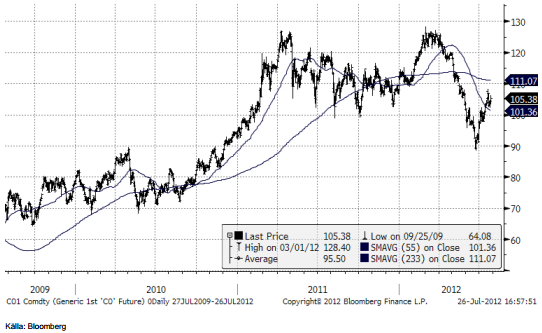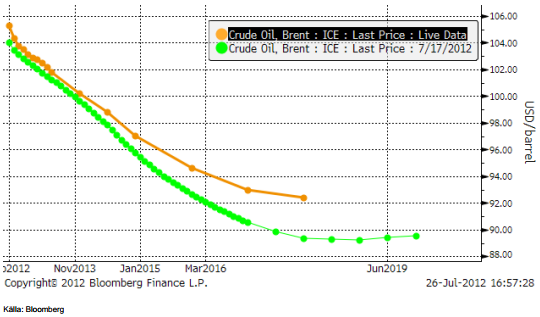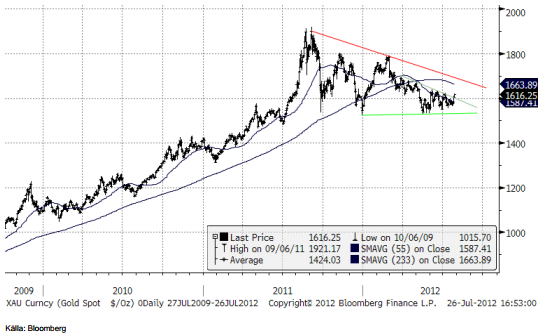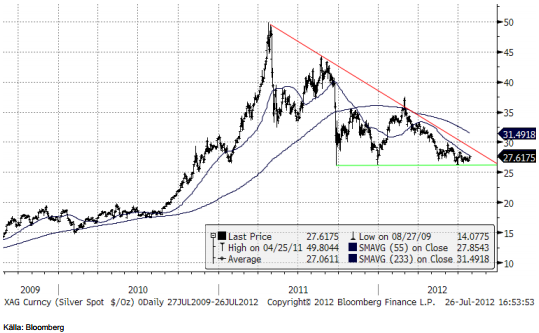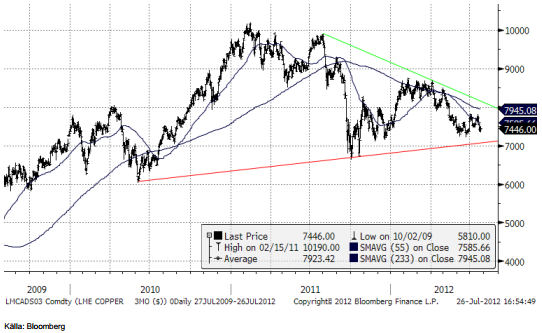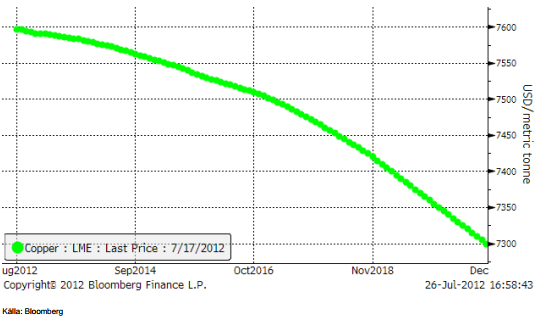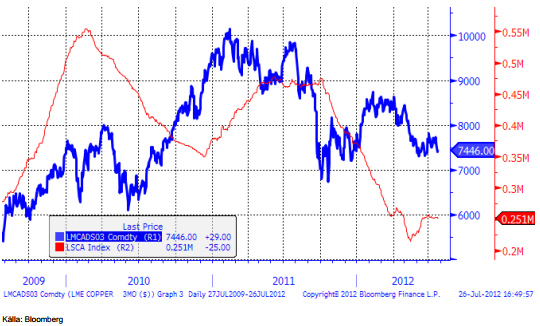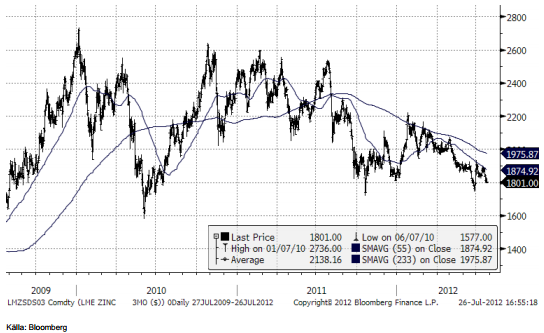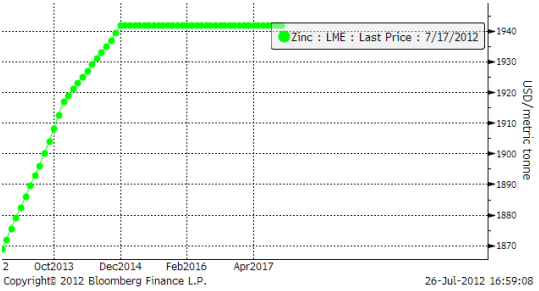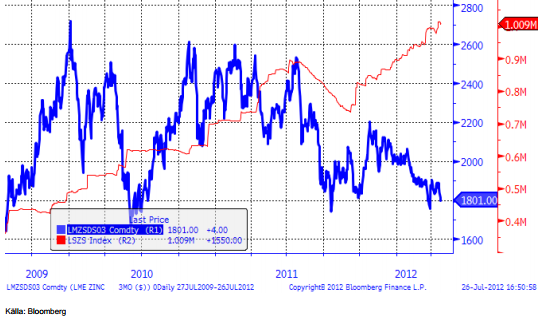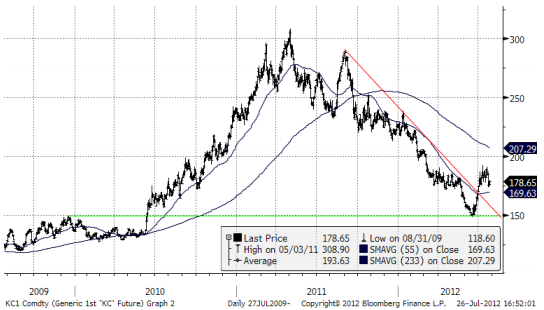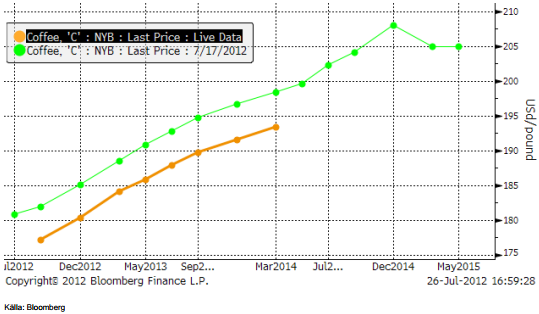Analys
SEB – Råvarukommentarer vecka 30
Sammanfattning av rekommendationer
Råvara – Rekommendation
Råolja – Köp OLJA S
Guld – Köp BULL GULD X4 S
Silver – Ingen rekommendation
Koppar – Köp KOPPAR S
Zink – Ingen rekommendation
Kaffe – Köp KAFFE S
Socker – Möjligen köp av SHORT SOCKE A S
Vete – Köp VETE S
Majs – Köp MAJS S
Sojabönor – Köp SOJABO S
Inledning
Den senaste månaden har majspriset stigit med 26%. Chicagovetet har gått upp med 25% och kostar nu återigen, för alla löptider, mer än Matif:s kvarnvete. Matif-vetet har ”bara” stigit med 18%. Sojabönorna med 14%. Vi fortsätter att ha en vy om högre priser på vete, maltkorn, majs, och sojabönor.
Vi har i princip köprekommendation på alla metaller, med tanke på stimulanser i Kina och att investeringar som vanligt sker under andra halvåret. Ett eventuellt QE3 kan också hjälpa till.
Europas problem är hotet mot väntade prisuppgångar.
Tekniskt börjar metallerna förlora momentum nedåt och ser ut att bottna ur från nedåtgående trender till sidledes. Produktionskostnaden ligger på de här nivåerna på metaller, utom för koppar. Det gör att det finns ett ”fundamentalt golv” för metallpriserna på nuvarande nivåer.
Brent tycker vi att man bör köpa på ”dippar” under 100 dollar.
Råolja – Brent
Den senaste månaden har priset på brentolja stigit upp från 90 dollar. Nu ligger priset över 100 dollar per fat. Orosmolnet är krisen i EU. Vad skulle hända om krisen förvärrades? Det är trots allt tämligen troligt, trots att ECB-chefen Mario Draghi idag drog i med brösttoner och försäkrade att ECB har oändligt stöd bland EU:s ledande politiker att lösa vilket problem som helst. Frågan är om en akut kris skulle leda till samma tvärnit i oljeefterfrågan som Lehman-krisen gjorde. Sedan 2005 producerade då OPEC så mycket de kunde, men när oljepriset i spåren efter Lehmankrisen fallit ner till 40 dollar lyckades Saudierna begränsa produktionen så att utbudet kunde dämpas och åstadkomma en effekt på priset.
Idag är beredskapen större än då. OPEC och saudierna har 2008 i gott minne. ECB likaså, liksom alla vi andra. Vi tror därför inte att ett prisfall på olja kan bli lika allvarligt, om en kris liknande Lehman-konkursen skulle inträffa. I och för sig är ett konkursande land inte lika stort som när en bank går omkull. Det är naturligtvis mycket större. Så det återstår att se vad som händer.
Just nu ligger priset på Brent för spotleverans över 100 dollar per fat och snittet hittills i år är 112.2 dollar per fat. Detta trots en svag tillväxt i USA och i Kina och i eurozonen. Samtidigt producerar Saudiarabien i närheten av det mesta de gjort på 30 år. Balansen i den globala oljemarknaden är stram med begränsad reservkapacitet. Risken kvarstår för produktionsbortfall i mellanöstern och vi går nu in i säsongsmässigt högre konsumtion. Detta borde tala för ett högre oljepris. Och oljepriset hade naturligtvis varit högre om inte EU hade så massiva problem. När vi fick positiva nyheter idag i form av Draghis kommentarer, reagerade oljepriset med att stiga. På nedsidan har vi Saudiarabiens prismål om 100 dollar per fat.
Ytterligare positiva faktorer är, som nämnt i inledningen, möjligheten för en kommande QE3 i USA, att Kinas stimulansåtgärder biter på den reala ekonomin och tillväxten, att jobless claims i USA igår förvånade på den positiva sidan.
Nedan ser vi kursdiagrammet på spotkontraktet på Brent. 90 – 100 dollar tycks Brent vara köpvärt. Samtidigt finns ett kortsiktigt tekniskt motstånd på ca 110 dollar.
Råvarucertifikat får sin avkastning inte endast från stigande priser, utan också på att över tiden tillgodogöra sig rabatter på terminer i förhållande till spot. Vi ser i diagrammet nedan att terminer är billigare än spot på Brent. Genom att över tiden köpa billigt och sälja till spot (dyrt), samlar man på sig vinster. Råvarucertifikat gör just detta genom sin konstruktion. De hämtar sin avkastning från terminskontrakt, som ”rullas” in i längre kontrakt när tiden gjort att det gamla kontraktet är nära förfall. Att köpa t ex OLJA S, ochsitta på det, kan därför ge ganska hög avkastning, även om priset på råolja väntar med att stiga.
Guld
Att priset på guld rört sig sidledes och något nedåt i ett år, har varit en prövning för många guldinvesterare. Tekniska analytiker har också noterat att glidande medelvärden signalerar ”sälj”, som vi ser i diagrammet nedan. Det börjar dra ihop sig för guldpriset att lämna sin sidledes rörelse. Tekniskt stöd finns strax under dagens nivåer. Jag har markerat nivån med en linje som binder ihop bottennoteringarna det senaste året. Vi har också sjunkande motståndsnivåer.
Men vi kan faktiskt se en liten positiv signal. De senaste dagarna har priset brutit ett litet motstånd. Priset i dollar ligger i skrivande stund i 1616 dollar och det är över ett kortsiktigt motstånd. Detta kan vara början på ett mer betydande brott uppåt.
Den som är lite modig kan försöka sig på att köpa ett certifikat med hög hävstång och hög förlustrisk om priset vänder ner. Ett sådant är BULL GULD X4 S. Det ger 4 gångers utväxling på prisuppgångar (och till nackdel om priset istället faller).
Silver
Liksom guld uppvisar silver samma konsolideringsmönster det senaste året. Sin vana trogen är detta mycket häftigare för silver än för guld. Stödet på ca 26 dollar per uns är tydligt i silvermarknaden. Jag har ritat in nivån i diagrammet nedan. Motståndet från toppen under våren 2011 är också tydligt. När marknaden når en sådan här punkt, där priset trängs mellan stöd och motstånd brukar endera köpare eller säljare vinna, vilket då avgör om priset ska upp eller ner. Det återstår att se – och då vara snabb att ta position i LONG eller SHORT SILVER S, vilket det nu än visar sig bli.
Koppar
Prisfallet på koppar har förlorat momentum och tycks bottna ut när nedåttrenden försvagas. Tekniskt finns det stöd strax under dagens nivåer. Det bör finnas potential för högre pris på koppar.
Bara att äga råvarucertifikat på koppar gör att man tjänar pengar, även om priset på koppar står still. Anledningen till detta är att kopparmarknaden är i backwardation, som vi ser i nedanstående diagram. När det är backwardation köper man terminer billigare än spot. Den rabatten blir en vinst över tiden. Koppar är en råvara som konsekvent över tiden ofta för att inte säga, nästan alltid, handlats med rabatt på terminerna. Trots att prisuppgången på t ex guld har varit så stor, har ändå en råvarucertifikatinvestering i koppar gett imponerande avkastning.
I nedanstående diagram ser vi kopparpriset och lagren i antal ton i LME:s lagerhus. Vi ser att lagrene har fallit sedan mitten av 2011. Konsumtionen är alltså större än produktionen. Det är ingen mekanisk sanning, men allt annat lika ”borde” sjunkande lager i vart fall ge stöd åt priset.
Vi rekommenderar köp av koppar, via ett råvarucertifikat utan hävstång och då är KOPPAR S ett sådant som skulle kunna placeras i.
Zink
Zinkpriset ligger på bottennivåer i det prisintervall som etablerats sedan 2009. Produktionskostnaden för zink ligger på dessa nivåer. I råvarumarknaden brukar man kalla detta för råvarans ”fundamentala golv”. Vi ser därför inte några stora kursfallsrisker i zink.
Zinkterminer handlas till skillnad från koppar och råolja i contango, dvs terminer är dyrare än spot. Det innebär att den som placerar i råvarucertifikat förlorar pengar, även om priset står still. Man skulle kunna se det som priset för att kursfallsrisken är begränsad av produktionskostnaden.
Lagren på LME har stigande på zink. Zink används mycket i byggindustrin (i stället för målarfärg på stål). När det är något av fastighetskris i stora delar av Europa är det inte förvånande att zinkmarknaden är under press.
Vi är positiva till zink, men inte lika mycket så som för koppar.
Kaffe
Priset på Arabica, som handlas i New York, har brutit sin nedåtgående trend, efter att ha varit nere på 150 cent per pund. 150 cent var toppnoteringen från slutet av 2009 och var därför för många en naturlig nivå att lägga in köpordrar på.
Det råder contango i terminsmarknaden för arabica-kaffe, som ser i nedanstående diagram.
Vi tycker att man kan börja köpa på sig certifikat på kaffe, på rekyler. Den rekyl vi har haft de senaste dagarna kan t ex vara ett sådant tillfälle. Om man inte önskar ta så hög risk kan råvarucertifikatet KAFFE S vara ett bra val.
Här väljer vi att klippa veckans utgåva SEBs nyhetsbrev Veckans Råvarukommentarer, då återstående innehåll även fanns i gårdagens SEB Jordbruksprodukter.
[box]SEB Veckobrev Veckans råvarukommentar är producerat av SEB Merchant Banking och publiceras i samarbete och med tillstånd på Råvarumarknaden.se[/box]
Disclaimer
The information in this document has been compiled by SEB Merchant Banking, a division within Skandinaviska Enskilda Banken AB (publ) (“SEB”).
Opinions contained in this report represent the bank’s present opinion only and are subject to change without notice. All information contained in this report has been compiled in good faith from sources believed to be reliable. However, no representation or warranty, expressed or implied, is made with respect to the completeness or accuracy of its contents and the information is not to be relied upon as authoritative. Anyone considering taking actions based upon the content of this document is urged to base his or her investment decisions upon such investigations as he or she deems necessary. This document is being provided as information only, and no specific actions are being solicited as a result of it; to the extent permitted by law, no liability whatsoever is accepted for any direct or consequential loss arising from use of this document or its contents.
About SEB
SEB is a public company incorporated in Stockholm, Sweden, with limited liability. It is a participant at major Nordic and other European Regulated Markets and Multilateral Trading Facilities (as well as some non-European equivalent markets) for trading in financial instruments, such as markets operated by NASDAQ OMX, NYSE Euronext, London Stock Exchange, Deutsche Börse, Swiss Exchanges, Turquoise and Chi-X. SEB is authorized and regulated by Finansinspektionen in Sweden; it is authorized and subject to limited regulation by the Financial Services Authority for the conduct of designated investment business in the UK, and is subject to the provisions of relevant regulators in all other jurisdictions where SEB conducts operations. SEB Merchant Banking. All rights reserved.
Analys
Brent crude ticks higher on tension, but market structure stays soft

Brent crude has climbed roughly USD 1.5-2 per barrel since Friday, yet falling USD 0.3 per barrel this mornig and currently trading near USD 67.25/bbl after yesterday’s climb. While the rally reflects short-term geopolitical tension, price action has been choppy, and crude remains locked in a broader range – caught between supply-side pressure and spot resilience.

Prices have been supported by renewed Ukrainian drone strikes targeting Russian infrastructure. Over the weekend, falling debris triggered a fire at the 20mtpa Kirishi refinery, following last week’s attack on the key Primorsk terminal.
Argus estimates that these attacks have halted ish 300 kbl/d of Russian refining capacity in August and September. While the market impact is limited for now, the action signals Kyiv’s growing willingness to disrupt oil flows – supporting a soft geopolitical floor under prices.
The political environment is shifting: the EU is reportedly considering sanctions on Indian and Chinese firms facilitating Russian crude flows, while the U.S. has so far held back – despite Bessent warning that any action from Washington depends on broader European participation. Senator Graham has also publicly criticized NATO members like Slovakia and Hungary for continuing Russian oil imports.
It’s worth noting that China and India remain the two largest buyers of Russian barrels since the invasion of Ukraine. While New Delhi has been hit with 50% secondary tariffs, Beijing has been spared so far.
Still, the broader supply/demand balance leans bearish. Futures markets reflect this: Brent’s prompt spread (gauge of near-term tightness) has narrowed to the current USD 0.42/bl, down from USD 0.96/bl two months ago, pointing to weakening backwardation.
This aligns with expectations for a record surplus in 2026, largely driven by the faster-than-anticipated return of OPEC+ barrels to market. OPEC+ is gathering in Vienna this week to begin revising member production capacity estimates – setting the stage for new output baselines from 2027. The group aims to agree on how to define “maximum sustainable capacity,” with a proposal expected by year-end.
While the IEA pegs OPEC+ capacity at 47.9 million barrels per day, actual output in August was only 42.4 million barrels per day. Disagreements over data and quota fairness (especially from Iraq and Nigeria) have already delayed this process. Angola even quit the group last year after being assigned a lower target than expected. It also remains unclear whether Russia and Iraq can regain earlier output levels due to infrastructure constraints.
Also, macro remains another key driver this week. A 25bp Fed rate cut is widely expected tomorrow (Wednesday), and commodities in general could benefit a potential cut.
Summing up: Brent crude continues to drift sideways, finding near-term support from geopolitics and refining strength. But with surplus building and market structure softening, the upside may remain capped.
Analys
Volatile but going nowhere. Brent crude circles USD 66 as market weighs surplus vs risk

Brent crude is essentially flat on the week, but after a volatile ride. Prices started Monday near USD 65.5/bl, climbed steadily to a mid-week high of USD 67.8/bl on Wednesday evening, before falling sharply – losing about USD 2/bl during Thursday’s session.

Brent is currently trading around USD 65.8/bl, right back where it began. The volatility reflects the market’s ongoing struggle to balance growing surplus risks against persistent geopolitical uncertainty and resilient refined product margins. Thursday’s slide snapped a three-day rally and came largely in response to a string of bearish signals, most notably from the IEA’s updated short-term outlook.
The IEA now projects record global oversupply in 2026, reinforcing concerns flagged earlier by the U.S. EIA, which already sees inventories building this quarter. The forecast comes just days after OPEC+ confirmed it will continue returning idle barrels to the market in October – albeit at a slower pace of +137,000 bl/d. While modest, the move underscores a steady push to reclaim market share and adds to supply-side pressure into year-end.
Thursday’s price drop also followed geopolitical incidences: Israeli airstrikes reportedly targeted Hamas leadership in Doha, while Russian drones crossed into Polish airspace – events that initially sent crude higher as traders covered short positions.
Yet, sentiment remains broadly cautious. Strong refining margins and low inventories at key pricing hubs like Europe continue to support the downside. Chinese stockpiling of discounted Russian barrels and tightness in refined product markets – especially diesel – are also lending support.
On the demand side, the IEA revised up its 2025 global demand growth forecast by 60,000 bl/d to 740,000 bl/d YoY, while leaving 2026 unchanged at 698,000 bl/d. Interestingly, the agency also signaled that its next long-term report could show global oil demand rising through 2050.
Meanwhile, OPEC offered a contrasting view in its latest Monthly Oil Market Report, maintaining expectations for a supply deficit both this year and next, even as its members raise output. The group kept its demand growth estimates for 2025 and 2026 unchanged at 1.29 million bl/d and 1.38 million bl/d, respectively.
We continue to watch whether the bearish supply outlook will outweigh geopolitical risk, and if Brent can continue to find support above USD 65/bl – a level increasingly seen as a soft floor for OPEC+ policy.
Analys
Waiting for the surplus while we worry about Israel and Qatar

Brent crude makes some gains as Israel’s attack on Hamas in Qatar rattles markets. Brent crude spiked to a high of USD 67.38/b yesterday as Israel made a strike on Hamas in Qatar. But it wasn’t able to hold on to that level and only closed up 0.6% in the end at USD 66.39/b. This morning it is starting on the up with a gain of 0.9% at USD 67/b. Still rattled by Israel’s attack on Hamas in Qatar yesterday. Brent is getting some help on the margin this morning with Asian equities higher and copper gaining half a percent. But the dark cloud of surplus ahead is nonetheless hanging over the market with Brent trading two dollar lower than last Tuesday.

Geopolitical risk premiums in oil rarely lasts long unless actual supply disruption kicks in. While Israel’s attack on Hamas in Qatar is shocking, the geopolitical risk lifting crude oil yesterday and this morning is unlikely to last very long as such geopolitical risk premiums usually do not last long unless real disruption kicks in.
US API data yesterday indicated a US crude and product stock build last week of 3.1 mb. The US API last evening released partial US oil inventory data indicating that US crude stocks rose 1.3 mb and middle distillates rose 1.5 mb while gasoline rose 0.3 mb. In total a bit more than 3 mb increase. US crude and product stocks usually rise around 1 mb per week this time of year. So US commercial crude and product stock rose 2 mb over the past week adjusted for the seasonal norm. Official and complete data are due today at 16:30.
A 2 mb/week seasonally adj. US stock build implies a 1 – 1.4 mb/d global surplus if it is persistent. Assume that if the global oil market is running a surplus then some 20% to 30% of that surplus ends up in US commercial inventories. A 2 mb seasonally adjusted inventory build equals 286 kb/d. Divide by 0.2 to 0.3 and we get an implied global surplus of 950 kb/d to 1430 kb/d. A 2 mb/week seasonally adjusted build in US oil inventories is close to noise unless it is a persistent pattern every week.
US IEA STEO oil report: Robust surplus ahead and Brent averaging USD 51/b in 2026. The US EIA yesterday released its monthly STEO oil report. It projected a large and persistent surplus ahead. It estimates a global surplus of 2.2 m/d from September to December this year. A 2.4 mb/d surplus in Q1-26 and an average surplus for 2026 of 1.6 mb/d resulting in an average Brent crude oil price of USD 51/b next year. And that includes an assumption where OPEC crude oil production only averages 27.8 mb/d in 2026 versus 27.0 mb/d in 2024 and 28.6 mb/d in August.
Brent will feel the bear-pressure once US/OECD stocks starts visible build. In the meanwhile the oil market sits waiting for this projected surplus to materialize in US and OECD inventories. Once they visibly starts to build on a consistent basis, then Brent crude will likely quickly lose altitude. And unless some unforeseen supply disruption kicks in, it is bound to happen.
US IEA STEO September report. In total not much different than it was in January

US IEA STEO September report. US crude oil production contracting in 2026, but NGLs still growing. Close to zero net liquids growth in total.

-

 Nyheter4 veckor sedan
Nyheter4 veckor sedanMeta bygger ett AI-datacenter på 5 GW och 2,25 GW gaskraftverk
-

 Nyheter4 veckor sedan
Nyheter4 veckor sedanAker BP gör ett av Norges största oljefynd på ett decennium, stärker resurserna i Yggdrasilområdet
-

 Nyheter4 veckor sedan
Nyheter4 veckor sedanSommarens torka kan ge högre elpriser i höst
-

 Analys4 veckor sedan
Analys4 veckor sedanBrent edges higher as India–Russia oil trade draws U.S. ire and Powell takes the stage at Jackson Hole
-

 Nyheter3 veckor sedan
Nyheter3 veckor sedanMahvie Minerals är verksamt i guldrikt område i Finland
-

 Analys4 veckor sedan
Analys4 veckor sedanIncreasing risk that OPEC+ will unwind the last 1.65 mb/d of cuts when they meet on 7 September
-

 Nyheter3 veckor sedan
Nyheter3 veckor sedanNeil Atkinson spår att priset på olja kommer att stiga till 70 USD
-

 Analys2 veckor sedan
Analys2 veckor sedanOPEC+ in a process of retaking market share



